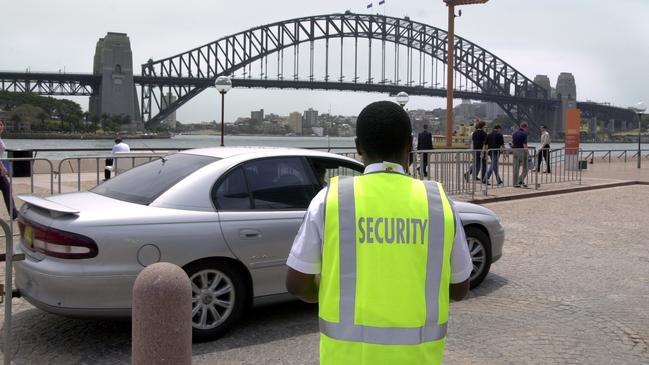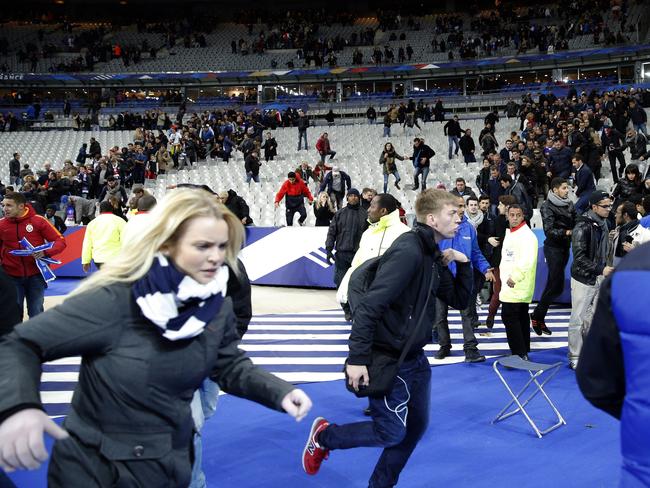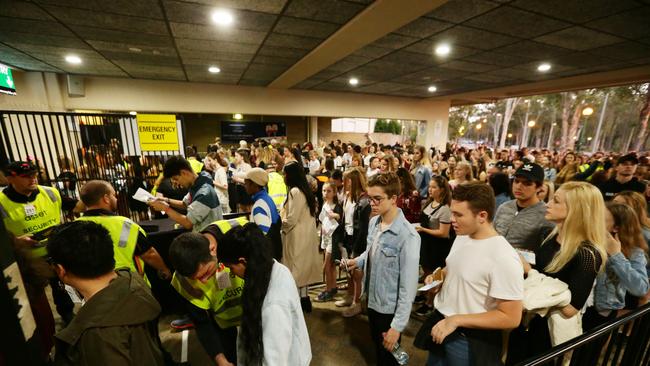Nation’s thin fluoro line between chaos and order
Our private security industry deserves more recognition.

On November 13, 2015, three suicide bombers attacked the national sports stadium, Stade de France, where the French president and almost 80,000 people were attending an international soccer game. One suicide bomber was stopped from entering the stadium by a private security guard who noticed the attacker’s hurried behaviour and attempt to enter the stadium without a ticket.
The attacker quickly fled capture but detonated the vest seconds later, killing himself and a bystander. It’s believed that the bomber intended to detonate the vest inside the stadium, triggering patrons to flee in a panic into the street, where two other suicide bombers were lying in wait.

In the Manchester terrorist attack at a concert arena in May last year, the denial of entry of the bomber to the auditorium by private security personnel reduced the number of fatalities because of panic and crowd crush. Security guards also provided lifesaving first aid after the bomb exploded in the foyer.
The role and contribution of private security services in preventing and responding to terrorism has been a neglected issue in Australia’s national security planning. The security guard force sector observes and reports suspicious activity. Security guards most often are the first people on the spot after a terrorist attack. Security personnel are responsible for implementing appropriate facility-level security plans, emergency response plans, crisis management and business continuity plans.
The security industry is vital to the continuous operation of Australia’s economy. Without security officers there would be no screening at airports. Hospitals, shopping centres and sports stadiums would be easy targets. Cash deliveries and the restocking of ATMs would cease. Licensed venues would be forced to close. There would be no monitoring of security alarm systems.
Most major providers of security guarding services, such as MSS Security, Wilson Security and Securecorp, are owned by overseas interests. Protection for major Australian airports and defence facilities has been provided by overseas-owned companies for many years. The primary concern relating to foreign ownership in the sector is potential access to sensitive information and equipment. If foreign ownership is considered a concern at specific sites, the owner can employ an in-house guard force.
It’s estimated that there are more than 120,000 licensed security guards and crowd controllers in Australia, of whom 54,753 were recorded as full-time workers in the 2016 census. By comparison, Australia has about 56,000 police and 58,000 permanent military personnel. The security workforce has a significant casual element, estimated at about 47 per cent. Because the private security industry lacks clearly defined career pathways, it has been a challenge to attract high-quality candidates to the industry.
Security officers are among the lowest paid people at most sites. From July this year, the base rate for a permanent full-time level 1 security officer is $21.26 an hour. For some, low wages are offset by the available work hours, which may support their study or primary employment elsewhere.
Because of Australia’s mutual recognition arrangements, a person with a licence in one jurisdiction can transfer it to another. This has resulted in “licence shopping”.
The issue was put before the Council of Australian Governments in July 2008. COAG agreed to adopt a nationally consistent approach to the regulation of the guarding sector to improve the probity and skills of security personnel and the mobility of security industry licences across jurisdictions. But in the decade since COAG met on the issue, significant changes have failed to materialise.
All security officers require the basic skills to identify, report on and respond to terrorist activity. But their training doesn’t specifically address counter-terrorism. Training courses should include material on recognising suspicious behaviour associated with pre-incident terrorism activities and how and where to report suspicious activities.
Our police and security agencies value the input of the general public in counter-terrorism, as demonstrated in campaigns such as “If it doesn’t add up, speak up”.

But there has been little outreach by police to the private security industry. That’s partly because of a lingering perception the guard force industry can’t be a trusted partner. The shadow of organised crime involvement still hangs over the sector, despite the considerable effort undertaken by all states to eliminate that influence. There’s even a reluctance by some state police forces to allow private security companies to use dog detection services for drugs or explosives. That’s despite security operators being able to contribute these capabilities. Internationally, dog detection services are available commercially and operate within legislative constraints to support law enforcement agencies in proactively screening crowds in major venues. Part of the image of the private security sector is based on reports of injuries and deaths caused by crowd controllers. But security officers or crowd controllers are far likelier to be injured than the public with whom they interact. One survey of security personnel found that 57 per cent of crowd controllers had experienced a major physical assault once or more in the past year and 86 per cent of crowd controllers had experienced a minor assault at least once.
Private security personnel can play an active role in feeding information to police and security agencies, potentially deterring an attack at the planning or reconnaissance stage.
This isn’t about the private security sector using armed response: an increase in the number of firearms in the community wouldn’t help. The primary response of private security officers to an armed assailant is to report the event, remove people from the area, isolate the offender where possible, render first aid and provide accurate witness statements.
But there’s a strong case for allowing more security guards, with appropriate training, to use plastic cuffs to provide safe restraint while reducing, and possibly eliminating, the risk of positional asphyxia.
One of the restricting factors within the guarding element of the private security sector is that there’s little opportunity for career progression. A security officer usually starts as a basic guard or crowd controller. Once they have gained sufficient experience, they may be appointed as a supervisor and be responsible for a number of guards or for a shift.
Revision of the licensing and training regimes would provide an opportunity to consider a tiered employment structure. Additional training and experience could be recognised through the creation of a level such as senior security officer.
Technology changes are affecting the capabilities of the guarding services through robots patrolling public places. Drones, facial software recognition and improved clarity and precision in visual surveillance systems are all helping to solve lots of security challenges.
But interpreting and reporting their observations will remain the domain of the security officer.
The guarding sector can work with local councils and others to provide security across city precincts, especially by integrating surveillance and communication technologies. Some examples of this are occurring, such as the Martin Place Security Forum in Sydney and information sharing around transport hubs and sporting venues in the Melbourne Docklands precinct.
We can learn from Project Griffin in London, designed to integrate the private security sector, including guards, with the city’s counter-terrorism plans. Oxford Street in London, for example, has around 300 shops and a half-million visitors daily. There are more than 2000 private security officers engaged every day, helping to keep the 1.9km street safe, working with a scale and focus not possible from police.
There’s a need to move to a national framework for security guarding licensing and training that aims higher than a lowest common denominator national or “floor” minimum standard.
A national security industry authority should be created. It would be a statutory body and could fulfil the required functions of centralising and controlling the identified elements of the private security guarding sector.
Such an authority, responsible to the home affairs minister, would enable government to set long-term policy requirements and expectations, and would remain at arm’s length from the detailed management of the sector. The authority would be able to develop consistent standards for the delivery of training and assessments and externally validated training and verification of competency.
It could work with state agencies to investigate breaches of national standards through the provision of states’ compliance and enforcement services as part of an agreement between the states and the security industry authority. Although the states may object to the loss of regulatory responsibility and income, some funding could be returned for the development of state-specific legal training for security officers and to assist with monitoring and compliance.
Australia’s national terrorism threat level has been “Probable — a terrorist attack is likely” since September 2014. Last year, that level was reaffirmed. Despite the persistent risk of a terrorist attack on Australian soil, the nation’s “eyes, ears and hands” — the private security industry — has been excluded from national counter-terrorism plans.
The wholly state-based model for the nation’s guard force, with light COAG co-ordination, has failed. A nationally consistent vetting, training and licensing system will greatly enhance the abilities of security officers to contribute to our overall national efforts to prevent and respond to terrorism.
Anthony Bergin is a senior analyst at the Australian Strategic Policy Institute and Australian National University’s National Security College. He is co-author of Safety in Numbers: Australia’s Private Security Guard Force and Counter-Terrorism, released this week.
-
By the numbers
120,000+ Number of licensed security guards and crowd controllers in Australia
54,753 Full-time security guards
56,000 Australian police force officers
58,000 Permanent military personnel
$21.26 Hourly base rate for a permanent full-time level 1 security officer
57% Crowd controllers who have experienced a major physical assault once or more in the past year
86% Experienced a minor assault at least once


